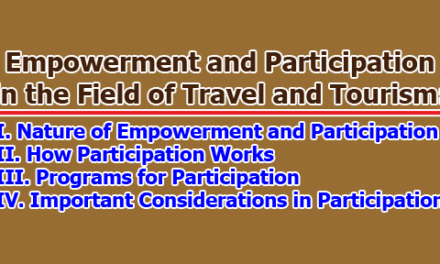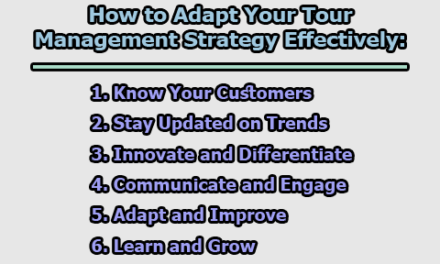Key Elements of Tourist Market Environment:
The tourist market environment is complex and constantly changing, and as such, tourism businesses need to be aware of the key elements that make up this environment in order to effectively operate and compete within it. In this response, we will discuss the four main key elements of the tourist market environment: customers, competition, costs, and changes.
1. Customers: Customers are the lifeblood of any tourism business, and it is important for tourism businesses to understand the characteristics, needs, and preferences of their customers. Customer segmentation is an important tool that businesses can use to identify different groups of customers and tailor their marketing efforts to these groups. Segmentation can be based on demographic factors such as age, gender, income, and education, or psychographic factors such as lifestyle, values, and interests. For example, a luxury hotel may segment its customers based on income and offer high-end services to attract wealthy customers, while a budget hotel may segment its customers based on price sensitivity and offer basic services at lower prices. Customers are a crucial element of the tourist market environment. Their preferences, behavior, and demographics can significantly impact the strategies and decisions of tourism businesses. Here are some sub-points to consider:
– Demographic factors: Demographic factors, such as age, gender, income, and nationality, can have a significant impact on customer behavior and preferences. For example, older customers may prefer quieter and more luxurious destinations, while younger customers may seek adventure and excitement. Understanding these differences can help tourism businesses tailor their products and services to different customer segments.
– Travel motivations: Customer travel motivations can also vary significantly. Some customers may be motivated by relaxation, while others may seek adventure or cultural experiences. Businesses need to understand these motivations and offer products and services that align with them. For example, a hotel targeting relaxation-seekers may offer spa services, while one targeting adventure-seekers may offer outdoor activities such as hiking or rafting.
– Customer behavior: Understanding customer behavior is also essential. Some customers may prefer to plan their trips well in advance, while others may be more spontaneous and book at the last minute. Tourism businesses need to understand these differences and adjust their marketing and pricing strategies accordingly.
– Customer feedback: Customer feedback can be a valuable source of information for tourism businesses. It can help businesses identify areas for improvement, as well as highlight areas of strength. Businesses need to be receptive to customer feedback and take it into account when making decisions.
– Technology: Technology is also a crucial factor in understanding customers in the tourism industry. More and more customers are using digital channels to research and book travel. Tourism businesses need to be aware of these trends and ensure that they have user-friendly websites and mobile applications. They also need to offer a seamless and convenient online booking process.
– Communication preferences: Customers may have different communication preferences, such as email, phone, or social media. Tourism businesses need to understand these preferences and offer different communication channels to cater to their customers’ needs. For example, younger customers may prefer to communicate via social media, while older customers may prefer phone or email.
2. Competition: Competition is another important element of the tourist market environment. Tourism businesses operate in a highly competitive market, where other businesses may be offering similar products or services to the same customers. It is important for businesses to identify their direct and indirect competitors and understand their strengths and weaknesses. Direct competitors are businesses that offer similar products or services to the same customer segments, while indirect competitors are businesses that offer substitute products or services. Tourism businesses need to be aware of their competitors and understand how they are positioning themselves in the market. Here are some sub-points to consider:
– Direct vs. Indirect Competition: Direct competition refers to businesses that offer similar products or services to the same target market. For example, hotels, airlines, and car rental companies all compete directly in the travel industry. Indirect competition, on the other hand, refers to businesses that offer similar products or services but to a different target market. For example, a hotel may compete indirectly with Airbnb, which offers accommodation to a different type of customer.
– Competitor Analysis: A competitor analysis can help businesses understand their competitors’ strengths and weaknesses. It can help them identify areas where they can differentiate themselves and gain a competitive advantage. For example, a hotel may conduct a competitor analysis and find that its competitors are not offering a particular type of service, such as an on-site spa. The hotel can then introduce an on-site spa as a point of differentiation.
– Branding: Branding is a crucial aspect of competition in the tourism industry. A strong brand can differentiate a business from its competitors and attract customers. For example, Marriott International is a well-known brand in the hotel industry, and customers may choose to stay at a Marriott hotel over a competitor because of the brand’s reputation for quality and service.
– Pricing: Pricing is another important factor in competition. Businesses need to understand their competitors’ pricing strategies and adjust their own prices accordingly. For example, a hotel may offer lower prices than its competitors to attract price-sensitive customers. Alternatively, it may offer higher prices to position itself as a luxury brand.
– Customer service: Customer service is another area where businesses can differentiate themselves from their competitors. Providing excellent customer service can lead to customer loyalty and positive word-of-mouth recommendations. For example, a hotel that offers exceptional customer service may be more likely to attract repeat customers and positive online reviews than a competitor with mediocre customer service.
– Innovation: Innovation can also be a source of competitive advantage. Businesses that are innovative and offer unique products or services can attract customers who are looking for something different. For example, a hotel may offer an eco-friendly experience by using sustainable materials and energy-efficient technologies.
3. Costs: Costs are a critical element of the tourist market environment. Tourism businesses have many different costs, including fixed costs such as rent and salaries, and variable costs such as utilities and supplies. Businesses need to carefully manage their costs to ensure that they are profitable and able to compete effectively in the market. Tourism businesses need to be aware of their costs and how they impact their profitability. Here are some sub-points to consider:
– Fixed Costs vs. Variable Costs: Fixed costs are costs that do not change regardless of the level of output, such as rent or salaries. Variable costs, on the other hand, are costs that vary with the level of output, such as supplies or labor. Tourism businesses need to understand their fixed and variable costs to determine their break-even point and profitability.
– Pricing Strategy: Pricing strategy is another important factor in managing costs. Businesses need to set prices that cover their costs and provide a reasonable profit margin. They also need to consider the pricing strategies of their competitors and the price sensitivity of their customers. For example, a hotel may offer lower prices during the off-season to attract more customers and cover its fixed costs.
– Technology and Automation: Technology and automation can help reduce costs by improving efficiency and productivity. For example, a hotel may use a property management system (PMS) to automate tasks such as reservations, check-ins, and check-outs. This can reduce labor costs and improve the customer experience.
– Energy and Resource Efficiency: Energy and resource efficiency can also help reduce costs. Tourism businesses can use energy-efficient lighting, heating, and cooling systems to reduce their energy bills. They can also use water-saving devices and recycle waste to reduce their resource costs. For example, a hotel may install low-flow showerheads and toilets and use renewable energy sources such as solar or wind power.
– Marketing and Advertising Costs: Marketing and advertising costs are another important factor in managing costs. Tourism businesses need to allocate a budget for marketing and advertising to promote their products and services. They also need to measure the effectiveness of their marketing campaigns and adjust their strategies accordingly. For example, a hotel may use social media advertising to target specific customer segments and measure the return on investment (ROI) of its campaigns.
– Taxes and Regulatory Costs: Taxes and regulatory costs are also important factors to consider. Tourism businesses need to be aware of the taxes and regulations that apply to their industry and location. They also need to comply with health, safety, and environmental regulations to avoid penalties and fines. For example, a hotel may need to pay a tourist tax or comply with building codes and fire safety regulations.
4. Changes: The tourism industry is constantly changing, and businesses need to be aware of these changes and adapt accordingly. Changes can include technological advancements, changes in customer behavior and preferences, and changes in the regulatory environment. Changes are an important element of the tourist market environment, as the tourism industry is constantly evolving and affected by various factors. Here are some sub-points to consider:
– Technological Changes: Technological changes have had a significant impact on the tourism industry, particularly in terms of how customers book their travel and accommodations. For example, the rise of online booking platforms such as Expedia and Booking.com has made it easier for customers to compare prices and book their travel arrangements. Similarly, the use of mobile apps has made it easier for customers to access information and book activities while on their trips.
– Economic Changes: Economic changes can have a significant impact on the tourism industry, particularly in terms of the availability of disposable income for travel. In times of economic downturns, consumers may be less likely to spend money on travel, which can lead to a decline in the tourism industry. Conversely, during economic booms, consumers may be more likely to spend money on travel, which can lead to growth in the tourism industry.
– Environmental Changes: Environmental changes can also have an impact on the tourism industry. For example, natural disasters such as hurricanes, floods, and wildfires can disrupt travel plans and cause a decline in the tourism industry. Similarly, changes in climate patterns and rising sea levels can affect the attractiveness of certain destinations and lead to a shift in the tourism industry.
– Social Changes: Social changes can also affect the tourism industry. For example, changes in demographics and lifestyles can lead to shifts in travel preferences. Younger generations may be more interested in adventure and eco-tourism, while older generations may be more interested in cultural tourism. Additionally, changes in social norms and attitudes can affect the types of activities and experiences that customers are interested in.
– Political Changes: Political changes can also have an impact on the tourism industry. For example, changes in visa requirements or political instability in a region can affect the number of visitors to a particular destination. Similarly, changes in government policies and regulations can affect the operations of tourism businesses and the overall tourism industry.
In conclusion, Understanding customers, competition, costs, and changes are essential for businesses that want to succeed in the tourism industry. By carefully managing their costs, adapting to changes in the market, and offering products and services that meet the needs and preferences of their customers, businesses can build a strong and sustainable presence in the tourist market.
References:
- Buhalis, D. (2000). Marketing the competitive destination of the future. Tourism Management, 21(1), 97-116.
- Rittichainuwat, B. N., & Chakraborty, G. (2009). Customer loyalty in e-commerce: an exploration of its antecedents and consequences. Journal of Retailing, 85(2), 243-259.
- Assaker, G., Vinzi, V. E., & O’Connor, P. (2011). Examining the effect of novelty seeking, satisfaction, and destination image on tourists’ return pattern: a two factor, non-linear latent growth model. Tourism Management, 32(4), 890-901.
- Morrison, A. M., & Anderson, D. A. (2002). The changing tourism environment: marketing challenges and opportunities. Journal of Travel & Tourism Marketing, 12(2-3), 1-16.
- Gretzel, U., Yuan, Y., & Fesenmaier, D. R. (2000). Preparing for the new economy: advertising strategies and change in destination marketing organizations. Journal of Travel Research, 39(2), 146-156.
- Sigala, M. (2013). Tourism and social media: Theories and practices. Routledge.
- Kim, H., & Fesenmaier, D. R. (2017). Persuasive destination information through social media: Effects of source type, message type, and generation on generation Y travel consumers. Journal of Travel Research, 56(1), 77-90.
- Paraskevas, A., & Arendell, B. (2007). Developing an effective strategy for tourism destination marketing. Journal of Travel & Tourism Marketing, 22(3-4), 47-61.
- Prideaux, B. (2000). The role of the public and private sectors in tourism planning and development in less-developed countries. Tourism Management, 21(5), 403-424.
- Page, S. J., & Connell, J. (2006). Tourism: A modern synthesis. Cengage Learning EMEA.

Library Lecturer at Nurul Amin Degree College










